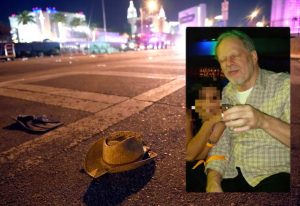(Akiit.com) The predictable began the instant Stephen Paddock mass murdered 59 persons and wounded hundreds more. That is the almost by now ritual handwringing, soul search and pop psychology rationalizations to explain the behavior of white mass murderers. There is the round the clock, non-stop coverage of investigators effort to find his motive for the carnage. In Paddock’s case, there is the dash to talk to every family member, friend, acquaintance, teacher, priest, rabbi, or even a parking attendant, that ever had any contact with him. The questions are always the same, “What was he like?” “Did you notice anything odd about his behavior?” “Did he say or do anything out of the ordinary?” Then there’s the almost obligatory revelation that the shooter suffered depression, high anxiety, was distraught, or with Paddock, he had aggressive tendencies. This leads to the equally inevitable revelation that he was on meds to treat his condition.
None of this is deliberately done to create public sympathy or depict the mass killer as an object worthy of sympathy. That’s impossible. However, it does inadvertently do so something that given the bestial nature of his crime is equally despicable; namely humanize him and his actions. The rush to try to understand, make sense of, and come to grips with the killer as a real person, is treatment that’s only reserved for white males. With few exceptions, they are the ones who routinely mass murder in America. And they are the ones who get the intense glare of media character studies and deep personality probes.
Countless studies have been cited that compare and contrast how whites who commit crime, even mass murder, are routinely apologized for, sanitized, psychoanalyzed, or simply ignored. This in brutal comparison to how blacks, even black victims of white crimes, are depicted. Following the slaying of Michael Brown by a white police officer in Ferguson, Missouri in 2014, the Huffington Post did a telling compare and contrast of the ritual apologetics for misbehavior or lawbreaking by whites and blacks citing several well-publicized recent cases. In an Alabama multiple murder case in 2010, the white suspect, a college professor, was described as “brilliant, but a social misfit.” In the shooting death of a Black in Montgomery, Alabama, the description was “the homicide victim had a history of narcotics abuse, tangles with the law.”
A New York man, who was a star athlete, killed his parents in 2010, was depicted as mentally challenged “brilliant, athletic—but his demons were the deaths of his parents.” Trayvon Martin, murdered by George Zimmerman, was repeatedly raked over the coals for alleged drug use, and his school suspensions. This in contrast to the 15-year-old Oregon school shooter who shot up his school in 2014, a headline read, “school shooting suspect fascinated with guns, but was a devoted Mormon, his friends say.” When mass murderer, Elliot Rodgers, went on his shooting rampage at U.C. Santa Barbara in 2014, there was much media soul searching trying to get inside his head. This was neatly summed up in a headline that read, “Suspect was soft-spoken, polite, a gentleman, says ex-principal.”
There were no such personality probes, human interest peaks, or psychoanalyst coach analysis for John Crawford III who was gunned down at a Walmart in Richland, Ohio, after a report that he was carrying a toy gun in the store. The state attorney general defended the shooting by claiming that the gun was not really a toy. Yet when an Ohio teen killed three students in 2012 he was described in a headline story as “a fine person.”
The template has been set in stone in just about every mass shooting by whites going back to Columbine in 1999. There is a desperate search to psychoanalyze the shooters, give a warm and fuzzy depiction about their backgrounds and up-bringing through interviews with their parents, teachers and friends, and then make it abundantly clear that they are aberrations. Blacks and Muslims whether accused of crime or victims get no such pass.
Then there’s the wildly contrasting terminology that used to describe white mass killers. They will not officially be branded as domestic terrorists. Trump typified that when the best he could sum up to say about Paddock is that he and his act were “evil.” That’s obvious. But even calling a mass killer evil avoids dealing with the far deeper and more damaging fact that America has been under assault for decades by white men with guns who are not afraid to kill anyone, anytime, for any reason. The death and destruction they wreak has threatened to turn the nation into a dangerous national security state that little by little erodes even more of our personal freedoms. Paddock was a terrorist, a true blue, red-blooded American, born and bred here, not in Afghanistan or Iraq.
The perennial search to explain him again fits neatly into the perennial pattern of writing off the killer, when he’s a white male, as a kook, crank, lone wolf or nut case, or, simply, an evil man. Paddock was that. But he was much more and making back door excuses for his and the monstrous carnage men like him create do nothing to confront the causes and consequences of made-in-America terrorism and terrorists.
Columnist; Earl Ofari Hutchinson
Official website; http://twitter.com/earlhutchins









Leave a Reply